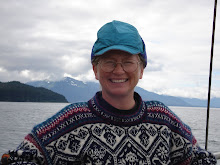EXPLORE
- What are some differences between traditional Native knowledge and Western science?
- Describe some of the common ground shared between these two world views.
I have found Canadian eskimo carvings, drawings and prints (See Eskimo Women Artists) more abstract than Alaskan work. Could it be an older culture longer using their art forms, from one of the older movements of peoples across the ice and water during the ice age as different from the later movements along the coast into southeast Alaska, interweaving with Stikine peoples and possibly others from the south?
Western social scientists incorporated facts (Emmonds), photographs (Sitka historical photographers clothing natives in sometimes incongruous native regalia), film (Curtis: In the Land of the War Canoes -- Kwakiutl movie using authentic clothing and war canoes in depiction of ways and challenges of life in the 20th century)
Western ethnographers at the turn of the 20th century (Emmonds and de Laguna) recorded stories of natives, changing the oral history truth into a written truth, which would be later be raked over for "factual" elements in photographs and words, unlike the oral traditions themselves. The respect by all for what was gathered is a point of common ground.
(*See my next week's quotes from stories of Grouse Fort in Glacier Bay and the Yakutat people's stories of coming through the glacier into being in the west.)
Only recently in Glacier Bay have archeologists and anthropologists their insights from at times obscure stories into actually helping recreate scenes and find remains which prove (in the Western request) timelines and actual historical events. Things match up remarkably. (*same reference)
Place names in the Western world named each mountain peak, bay and river with the name of a scientist or a patron of the scientists coming to Glacier Bay. In the 1970's, the Superintendent of Glacier Bay put a moratorium on naming features in Glacier Bay. In the last 10 years, a project has come to fruition with mutual work between Glacier Bay anthropologist Wayne Howell and the Dauenhauers from Hoonah and Juneau, with the Historical Foundation (name?) in creating an on-line living history map of Glacier Bay, where students from Hoonah have found names of places throughout Glacier Bay from elders and written documentation, and placed them on a google-earth-like map. Moving a pointer to a point of bay or mountain, the native word in Tlingit shows up, and in many cases an informative depiction of how the name came to be and what it means is shown.
Curiously, this wonderful creation is not available to just anyone. I would hope that in the future young people and others living in the Glacier Bay region (Gustavus school children, etc.) might have access to this information. This common ground seems really important to pursue.
I grew up in S.E. Alaska. Going to elementary school, I was among Tlingit, Filipino, and non-native kids. I learned well that stories were OK, but that stories and songs are owned and only told or sung with permission, usually between natives only. This is contrary to western ways of sharing/teaching a story or song to anyone. It becomes touchy when non-natives consider publishing native information, which is not looked highly on.
NW Coast Carving has continually been a connection from past to present for all native people; anyone can learn to carve in this style, but to find one's own elements of ownership of story/characters is important. It is a beautiful creative force.
Ownership of traditional art, or at.oo (sp?) items for a native person is limited to what one has inherited. One's inherited art is unlike something one purchases in the western ownership of art perspective. Also, there are regional/tribal differences which stand for a particular area and people; i.e. Chilkat weaving coming from Haines area; beadwork from the Yukon, but not in S.E.; transformational art of the Yupik; aleut hat designs; war canoe vs. work canoe designs; use of feathers, beads, wood, stone -- each in its own environment.
EXTEND
- What are some educational implications or opportunities presented by applying both ways?
- What other resources may be useful in integrating both perspectives?
- connecting Hoonah and Gustavus students once again on ethnological, cartography, language and future cooperative visits to native place-named spots in Glacier Bay
- creating art both in Hoonah and Gustavus by students depicting elements of place-named specific recognized places
- researching place names, both native and non-native
- finding archeological/anthropological evidence recorded at Glacier Bay National Park
- researching oral histories; transcribing historical tapes at GBNPS.
- introducing and continuing NW Coast Art on a regular basis in both communities, including use of NW Coast tools: bent knives,
- comparing/contrasting native place names in different regions (Alutiq, Koniak, Tlingit, Aleut, Kwakiutl, Tsimshian, Haida, Yupik, Inupiak, ...)
- creating new maps with traditional information; continuing and supporting current information
- Emmonds
- de Laguna
- historical NPS mythical/historical books
- NPS Glacier Bay cassettes of oral histories and music
- traditional Hoonah regalia owned by individuals
- movie by Edward Curtis;
EVALUATE
- What are some of the values of knowing both ways?
- Describe the utility of the ideas and/or resources presented in this section.


No comments:
Post a Comment